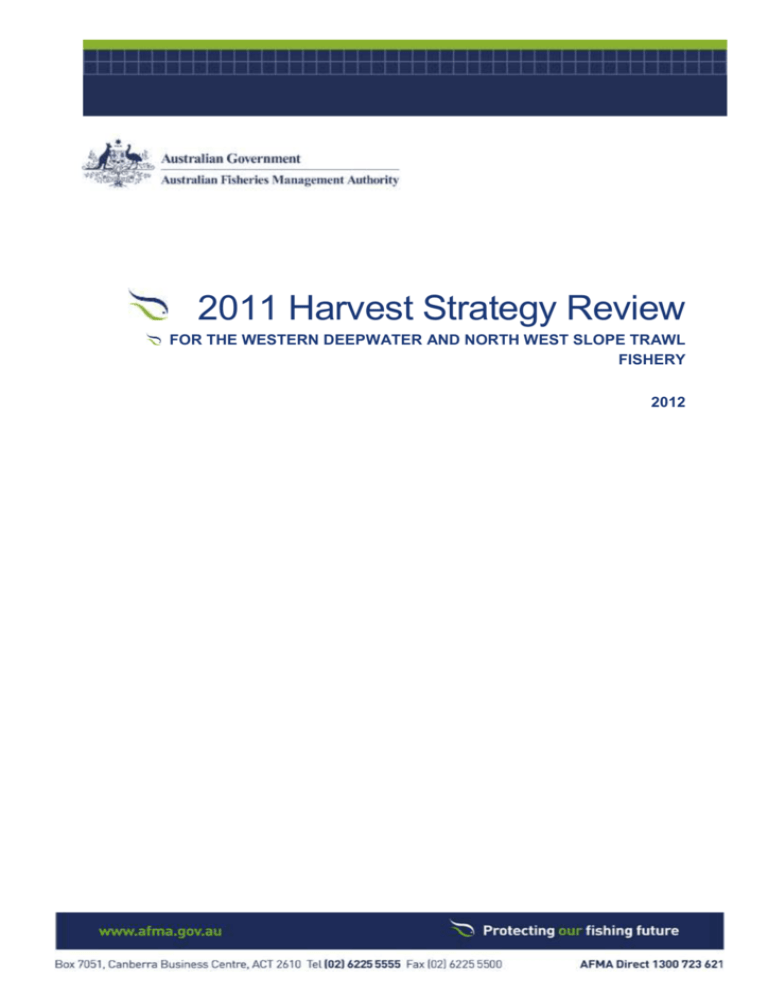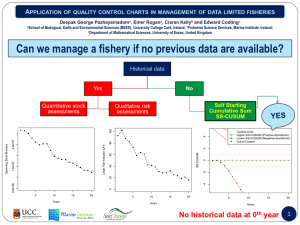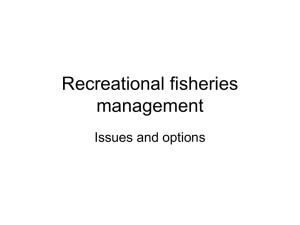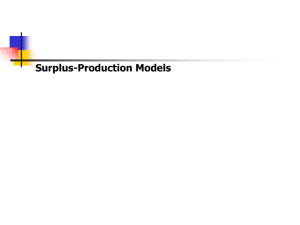Contract
advertisement

2011 Harvest Strategy Review FOR THE WESTERN DEEPWATER AND NORTH WEST SLOPE TRAWL FISHERY 2012 TABLE OF CONTENTS Table of Contents ........................................................................................................................ 2 Introduction ................................................................................................................................. 3 Summary of Results .................................................................................................................... 3 Background ................................................................................................................................. 4 Western Deepwater Trawl Fishery .............................................................................................. 4 North West Slope Trawl Fishery ................................................................................................. 4 Harvest strategy Key considerations ........................................................................................... 5 Reference Points and Triggers .................................................................................................... 6 Results ......................................................................................................................................... 7 Pilbara Region ............................................................................................................................. 9 Kimberley Region ..................................................................................................................... 10 Recommendations ..................................................................................................................... 12 References ................................................................................................................................. 13 2 INTRODUCTION The 2011 Western Deepwater Trawl Fishery (WDTF) and North West Slope Trawl Fishery (NWSTF) Harvest Strategy (AFMA, 2011) (the Harvest Strategy) is a key input into the management of the WDTF and NWSTF. The Harvest Strategy sets targets and management triggers against catch and effort parameters for target and non-target species. Under the Harvest Strategy analysis of catch and effort data is conducted annually. The analysis informs management and if triggers have been reached, what management action is required. This Harvest Strategy review is the first analysis of catch data since the Harvest Strategy was endorsed in 2011. Catch data from the 2011 fishing season was used for the analysis. SUMMARY OF RESULTS The benefit of the Harvest Strategy is that it is designed to monitor the NWSTF and WDTF and provide mechanisms to allow for sustainable fishing should catch and effort levels increase. There were low catch and effort levels in both the NWSTF and WDTF in 2011 and both fisheries are considered to be underutilised. There are spatial closures in place in both fisheries to ensure that marine habitats are protected from both the real and perceived effects of demersal trawling and provide confidence that the resource will continue to be sustainable. The variable catch and effort levels within both fisheries means that even a small change can result in seemingly large fluctuations from year to year in Catch per Unit of Effort (CPUE). It is because of this, that the Harvest Strategy trigger limits need to be reached in two consecutive years before further investigation is undertaken. With these measures in place, stock levels will remain above the Limit Reference Point1 at least 90% of the time. The 2011 review found that no species reached a management trigger, but four species were recommended for close monitoring during the 2012 season. A review of the 2012 fishing season against the Harvest Strategy will be conducted in 2013. 1 Refer to ‘Reference Points and Triggers’ section of this document for full explanation. 3 BACKGROUND Western Deepwater Trawl Fishery The WDTF is managed primarily through limited entry, spatial management, ecological risk assessment and the Harvest Strategy. The fishery is accessed on an opportunistic basis and is best classified as a mixed fish / byproduct species fishery due to a wide range of species taken in low volumes. In recent years, bugs (spp.) have been targeted and now form the majority of the catch. The fishery is characterised by two distinct areas: North and South of 27°S (Moore et al. 2007) to complement WA Fisheries jurisdictions. The “Gascoyne” region is to the north of 26.5°S, and the “West” region is to the south of 26.5°S (Figure 1). Figure 1. Area of operation for the WDTF. North West Slope Trawl Fishery The NWSTF is also a limited entry fishery, combined with controls on codend mesh size (maximum mesh size of 50mm), ecological risk assessment and the Harvest Strategy. The fishery has two regions: the “Pilbara” to the West of 120°E; and the “Kimberley” to the East of 120°E (Figure 2). 4 Finfish are the main target species in the area accessible to Commonwealth trawlers less than 200m depth. Scampi are targeted in waters greater than 200m in depth. Figure 2. Area of operation for the NWSTF. HARVEST STRATEGY KEY CONSIDERATIONS The Harvest Strategy was developed in line with the Commonwealth Fisheries Harvest Strategy Policy (HSP, 2007). It details controls for key commercial species, key indicator species and high risk species. In addition to these management controls, there are also bycatch and discarding work plans, ecological management zones, spatial closures and monitoring and research requirements. The complementary set of management measures combine to manage the WDTF and NWSTF. More details can be found on AFMA’s website for both the NWSTF and WDTF. An important aspect when considering the Harvest Strategy and annual catch data, is that both the WDTF and NWSTF are underutilised. This means that both fisheries have scope for sustainable development and this has been built into the Harvest Strategy by way of reference points and triggers based on historical effort and catch levels. It allows for sustainable development whilst mitigating the potential risk of overfishing by setting conservative CPUE reference points and management triggers. This means that even a minor deviation from historical levels, whether an increase or decrease in catch will trigger further investigation. 5 The benefits to this management approach are that while catch and effort levels are low, data collection and research requirements are also low. Should the catch rates increase, data collection and research requirements also increase, which industry will have the capacity to fund due to corresponding increases in production. The Harvest Strategy also provides for some species to move to management under more sophisticated stock assessment techniques (e.g. based on size/age data) should catches remain at higher levels over time. REFERENCE POINTS AND TRIGGERS There are three main indicators which CPUE data is analysed against to form the basis of this Harvest Strategy Review and subsequent recommendations. Details of triggers and reference points can be found in the Harvest Strategy on AFMA’s website. Limit Reference Point (LRP) The Limit CPUE is based on a CPUE indicator derived from the average annual nominal CPUE for the period 2000-2010 inclusive. This assumes that because there has been negligible or low fishing pressure during many years over this period, the average CPUE represents a proxy for an unfished biomass. The Limit CPUE should correspond to a level of stock depletion at which the risk to the stock is unacceptably high. Under the Harvest Strategy Policy a stock size corresponding to 20% of unfished biomass is a suitable proxy for the LRP. Target Reference Point (TRP) The TRP is designed to ensure that stocks are maintained (on average), at a size which produces the maximum economic yield from the fishery. In opportunistic data-poor fisheries such as the WDTF and NWSTF, there is a high degree of uncertainty about how to define such a reference point. Instead, two catch triggers have been implemented at which point further data analysis and reporting is required. These triggers aim to minimise risk associated with expansion and development of the fishery, by detecting and responding to development of the fishery at an early stage and, through relatively low-cost analyses, to identify the reasons behind these changes without immediately placing limitations on the fishery. ERA high-risk species Triggers Quantitative Ecological Risk Assessments (ERA) have been conducted for both the WDTF and NWSTF. This process has identified priority species to consider when managing the 6 ecological effects of fishing. The highest level of risk assessment (level 3) resulted in no high risk species with the level 2 risk assessment highlighting some high risk species which are subject to specific control rules. As a developing fishery, the ERA process recognises that there is potential for effort levels to increase in future years and the Harvest Strategy provides for this. RESULTS Western Deepwater Trawl Fishery Effort in the WDTF was minimal in 2011 with one vessel operating over four fishing days. Bugs were targeted while cuttlefish, scampi and squid were retained as byproduct. All fishing occurred in the West region of the WDTF with a total catch of 4.546 tonnes. No fishing occurred during 2011 in the Gascoyne region by Commonwealth permit holders. During 2011, no triggers were reached with catch rates for target species above the Limit CPUE. No other triggers were reached in relation to the target reference point and ERA triggers. This indicates the proxy unfished biomass has remained constant requiring no changes in management. Table 1 outlines the catch rates of key commercial species in relation to Limit CPUE for the WDTF. Table 1. Catch rates of key commercial species in the West Region of the WDTF showing trigger values for the Limit CPUE2 (green = no trigger; orange = monitor for following season; red = trigger). Species Limit CPUE (kg/day) 2011 Catch (t) 2011 CPUE (kg/day) West Region Scampi 14.4 0.162 40.5 Bugs 78 3.66 915 Figure 3 shows the catch in the WDTF and the proportion of the catch caught in the West and Gascoyne regions from 2000-2011. 2 Trigger limit species and values for the target reference point are not shown or discussed as none of these were triggered. 7 Figure 3. Total catch (kg) plus the number of boats in the WDTF, split between the West and Gascoyne Regions 2000 – 2011. 400000 7 350000 6 300000 Catch Weight (kg) 5 250000 4 200000 West Gascoyne 3 Number of Boats 150000 2 100000 1 50000 0 0 2000 2001 2002 2003 2004 2005 2006 2007 2008 2009 2010 2011 North West Slope Trawl Fishery Two vessels operated in the NWSTF in 2011, retaining a total of 86.5 tonnes with catch dispersed between the Pilbara and Kimberly Regions. Figure 4 is a summary of the catch in the NWSTF and the catch proportions in the Kimberley and Pilbara regions from 2000-2011. Figure 4. Total catch (kg) plus the number of NWSTF boats, split between the Kimberley and Pilbara regions 2000 – 2011. 250000 14 12 200000 Catch Weight (kg) 10 150000 8 Pilbara Kimberley 6 100000 Number of Boats 4 50000 2 0 0 2000 2001 2002 2003 2004 2005 2006 2007 2008 2009 2010 2011 8 Pilbara Region A total of 85 days were spent in the Pilbara region of the NWSTF with a total catch of 33.995 tonnes. No triggers were reached, with seven key commercial species above the Limit CPUE and three key commercial species falling below the Limit CPUE in 2011. These three species will be monitored during the 2012 season. Boschma’s scampi (Metanephrops boschmai) was one species that fell below the Limit CPUE. On review of this trigger AFMA found there were similarities between Boschma’s scampi and Velvet scampi (Metanephrops velutinus) such as physical appearance and overlapping depth ranges. Figure 5 illustrates the species images of Boschma’s and Velvet scampi and how similar they look. If 1.5 t of the Velvet scampi was in fact Boschma’s scampi the CPUE would be above the Limit CPUE for both species. AFMA will continue to monitor catches and a full review will be undertaken if the Limit CPUE is triggered in two consecutive years. Figure 5. Boschma's scampi (left) and Velvet scampi (right). Boschma scampi occurs in 260360m but mainly in 300-320m. Velvet scampi occurs in 238-702m but mainly in 350-450m depth. (Wadley and Evans, 1991). It is also important to consider that the low fishing effort and opportunistic nature of the fishery together with its spatial and temporal variability can result in >100% changes in CPUE from year to year. Red Prawn and Royal Red Prawn catches also fell below the Limit CPUE. The catch for both prawn species has been erratic for the last 12 years and with low levels of effort in the fishery resulting in fluctuating CPUE data. The CPUE limit control rule ensures that the stock stays above the Limit CPUE at least 90% of the time (i.e. a one in ten year risk that stocks will fall below). The Harvest Strategy recognises that low levels of effort result in variable CPUE results and as a result, a full review is not triggered unless the Limit CPUE is research in two consecutive years. 9 Table 2 (below) outlines the key commercial species showing trigger values for the Limit CPUE for the NWSTF Pilbara region and the outcomes of the catch data review. Table 2. Key commercial species in the Pilbara region of the NWSTF showing trigger values for the Limit CPUE (green = no trigger; orange = monitor for following season; red = trigger). Species Limit CPUE (kg/day) 2011 Catch (t) 2011 CPUE (kg/day) Pilbara Region Australian Scampi 31.9 21.504 253.75 Boschma’s Scampi 25.4 0.756 8.92 Velvet Scampi 21.2 3.55 41.89 Scampi Mixed 30.5 0 0 Total Scampi 39 25.81 304.56 6.4 0 0 Red Carid 6.8 2.065 24.37 Red Prawn 11.5 0.05 0.59 Red Striped Prawn 5.9 0.659 7.78 Royal Red Prawn 16.5 1.308 15.43 Total Deepwater Prawns 18.2 4.082 48.17 Giant Scarlet Prawn# # denotes high risk species. Kimberley Region A total of 48 fishing days were spent in the Kimberley Region, with 52.6 tonnes of retained catch. Within the Kimberley Region, there are two main areas: waters of depth greater than 200m and waters less than 200m. Finfish are primarily targeted in shallower waters with scampi and deep water prawns targeting in the deeper water. Changes in species catch composition can be influenced by seasonal variation, identification challenges and changes in effort. Of the eight species with a designated limit CPUE, only one species (Redspot Emperor [Lethrinus lentjan]) fell below the Limit CPUE. As discussed above, the nature of the fishery means that 100% changes in CPUE can occur from year to year. For a management response to be triggered, CPUE must drop below the Limit two years in a row. No other triggers were reached. Table 3 (below) outlines the key commercial species caught, related to the trigger Limit CPUE for the Kimberley region of the NWSTF. 10 Table 3 Key commercial species in the Kimberley region of the NWSTF showing values for the Limit CPUE (green = no trigger; orange = monitor for following season; red = trigger). 2011 Catch 2011 2011 CPUE with Limit 2011 CPUE with Species Catch Observer data CPUE (kg/day) Observer (t) (kg/day) data (t) Kimberly Region Aus Scampi 24.3 2.727 178.76 n/a n/a Boschma’s Scampi 46.5 0 0 n/a n/a Velvet Scampi 27.4 0.972 63.72 n/a n/a Scampi Mixed 27.7 0 0 n/a n/a Total Scampi 33.1 3.699 242.48 n/a n/a Redspot Emperor 101.2 1.6 48.4848 1.816 55.03 Saddletail Snapper 67.6 8.54 258.788 11.589 351.18 Goldband Snapper 168.8 5.835 176.818 6.453 195.55 Red Emperor 24.6 0.64 19.3939 1.003 30.39 Sharptooth Jobfish 8.365 253.485 9.618 291.45 Mangrove Jack 3.84 116.364 4.142 125.52 Crimson Snapper 3.895 118.03 4.031 122.15 Robinson's Seabream 1.82 55.1515 2.187 66.27 Northern Pearl Perch 0.625 18.9394 0.839 25.42 As with Boschma’s scampi and Velvet scampi, there are similarities between Goldband snapper (Pristipomoides multidens) and Sharptooth jobfish (Pristipomoides typus). Figure 6 illustrates the physical similarities between the two species. Both of these species are also cross-jurisdictional and caught in both State and Commonwealth fisheries. AFMA and WA Fisheries manage both stocks and continue to collect data on the species, which will assist with further development of collaborative management arrangement for these species. Figure 6. Sharptooth jobfish (left) and Goldband snapper (right). 11 Some concerns have been raised in relation to discards from trawl operations in the Kimberley region. In some areas of the Kimberley region there is a requirement for 100 per cent observer coverage. Data collected on these trips, which were undertaken the AFMA Scientific Observer Program in 2011, indicate that for every one kilogram of retained product, 0.17 kg of product was discarded. This is a relatively low retained catch to bycatch ratio in a trawl fishery with studies finding bycatch rates of between 30 and 80 per cent in different trawl fisheries around the world. RECOMMENDATIONS The nature of both the NWSTF and WDTF is defined by mixed species, mixed methods, temporal and spatial variability and large fluctuations in CPUE from year to year. In recognition of the varied nature of these fisheries, the Harvest Strategy triggers are set up so responses are appropriate and allow for natural fluctuations in CPUE, that is, a full review is triggered if the CPUE falls below the limit reference point for two consecutive years. As this was the first annual review of the Harvest Strategy, no management triggers occurred. The following recommendations are made for the second year of the Harvest Strategy: 1. Closely Monitor the four species whose catch rates fell below the Limit CPUE in 2011: a. Boschma’s Scampi b. Red Prawn c. Royal Red Prawn d. Redspot Emperor 2. AFMA to undertake an annual review of the effectiveness of the ‘move on’ permit conditions in the NWSTF 3. Review the list of species reported through logbooks and observer trip reports and compare this against the species identified in the Harvest Strategy. If a species was caught in sufficient quantities, review if development of triggers is required for that species e.g. Sharptooth Snapper. 12 REFERENCES AFMA 2011. Harvest Strategy for the Western Deepwater Trawl Fishery and North West Slope Trawl Fishery. Australian Fisheries Management Authority 18pp. AFMA 2011. Southern and Eastern Scalefish and Shark Fishery Management Arrangements Booklet. Australian Fisheries Management Authority 76pp. Department of Fisheries 2011. State of the Fisheries and Aquatic Resources Report 2010/2011. Fletcher, W.J and Santoro, K. (eds). Department of Fisheries, Western Australia 359pp. Moore, A.S., Gerner, M and Patterson, H.M. 2007. Western Deepwater Trawl Fishery Data Summary 2006. Australian Fisheries Management Authority, Canberra. Sainsbury, K.J., R.A. Campbell, and A.W. Whitelaw. 1993. Effects of trawling on the marine habitat on the north west shelf of Australia and implications for sustainable fisheries management. Pp. 137-145 In D.A. Hancock, ed. Sustainable Fisheries Through Sustaining Fish Habitat. Canberra, Australia, Australian Government Publishing Service. Wadley, V. and Evans, D. 1991. Crustaceans from the Deepwater Trawl Fisheries of Western Australia. CSIRO Division of Fisheries. 44pp. 13









